Today’s post is a mixed bag of recent birds I’ve photographed and some observations (with photos) from the field.
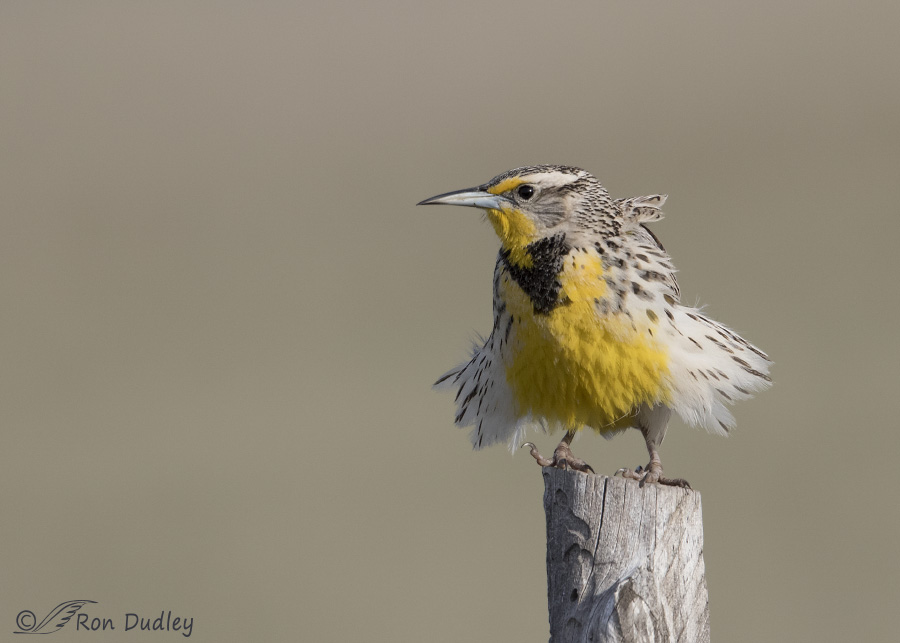
1/2500, f/6.3, ISO 800, Canon 7D Mark II, Canon EF 500mm f/4L IS II USM + 1.4 tc, not baited, set up or called in
We had some wind two days ago on Antelope Island and this Western Meadowlark’s dignity paid the price. The breeze flared some of its feathers to give it a decidedly undignified look. To add to that theme, check out the weird angle of one of its toes on its right foot. When I’ve had a muscle cramp in a toe it’s felt like it was trying to assume this position and it really hurts. I’ve never noticed a bird do this with a toe before – it’s no biggie but it did make me smile.
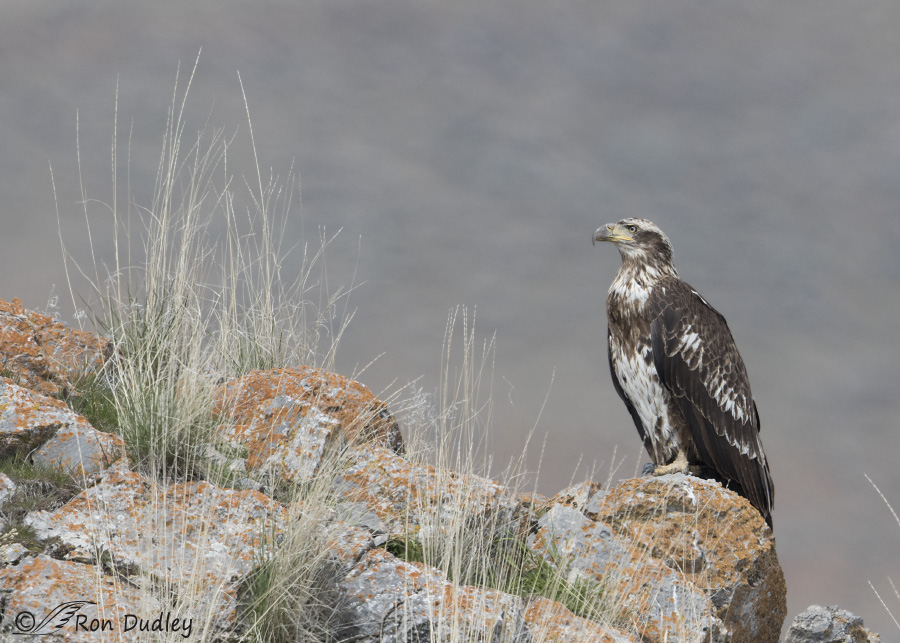
1/1600, f/7.1, ISO 500, Canon 7D Mark II, Canon EF 500mm f/4L IS II USM + 1.4 tc, not baited, set up or called in
I found this immature Bald Eagle four days ago in a remote area of Box Elder County, Utah. Many hundreds of Bald Eagles winter in northern Utah but very few of them are resident year-round and most headed north weeks ago. But this year stragglers may be staying later than usual as I’ve also seen several other Bald Eagles in the area recently. I’m not complaining because I enjoy having them around…
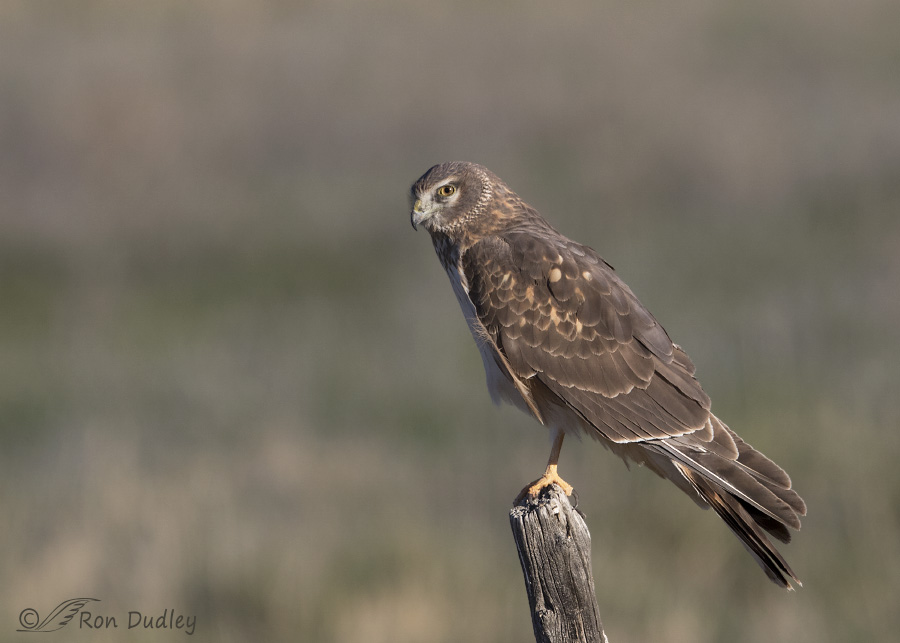 1/3200, f/6.3, ISO 500, Canon 7D Mark II, Canon EF 500mm f/4L IS II USM, not baited, set up or called in
1/3200, f/6.3, ISO 500, Canon 7D Mark II, Canon EF 500mm f/4L IS II USM, not baited, set up or called in
This Northern Harrier, photographed yesterday, was one of the tamest of the species I’ve ever encountered. Harriers are notorious for their spookiness but this one seemed to enjoy, even encourage, having its picture taken. I repeatedly passed it as it was perched on a fencepost very close to the road and it didn’t even flinch when a large truck came by in the lane even closer to the bird than I was. Notice that this image was taken without my teleconverter attached. I’ll definitely remember this bird.
I’ve watched a Common Raven nest next to a remote road in northern Utah for several years now. The nest has been active each year just as it has been this spring.
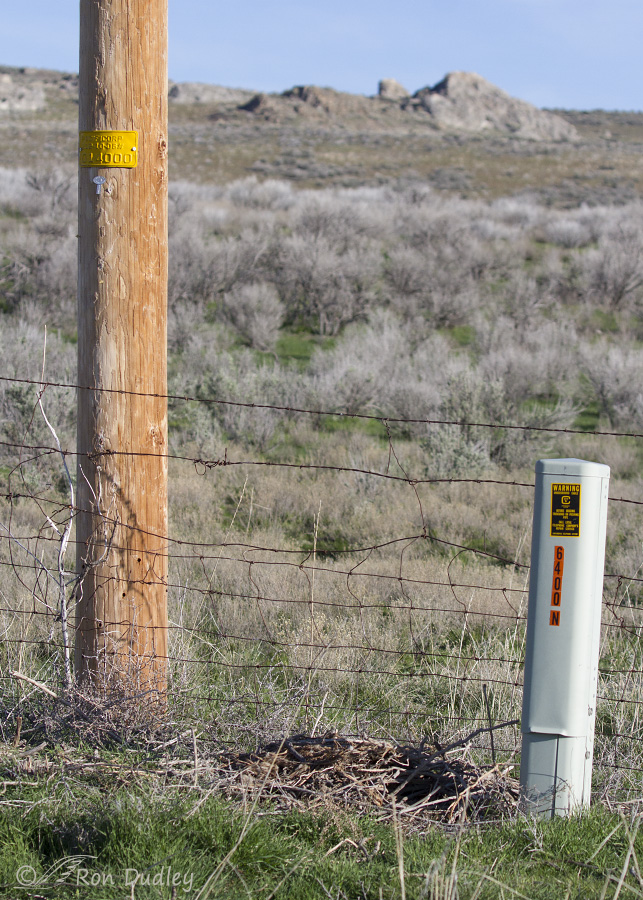
But five days ago – disaster. The nest was now on the ground at the base of the pole – there wasn’t even a single stick or twig left up top of the original nest. It may have been toppled by wind or by humans – who knows?
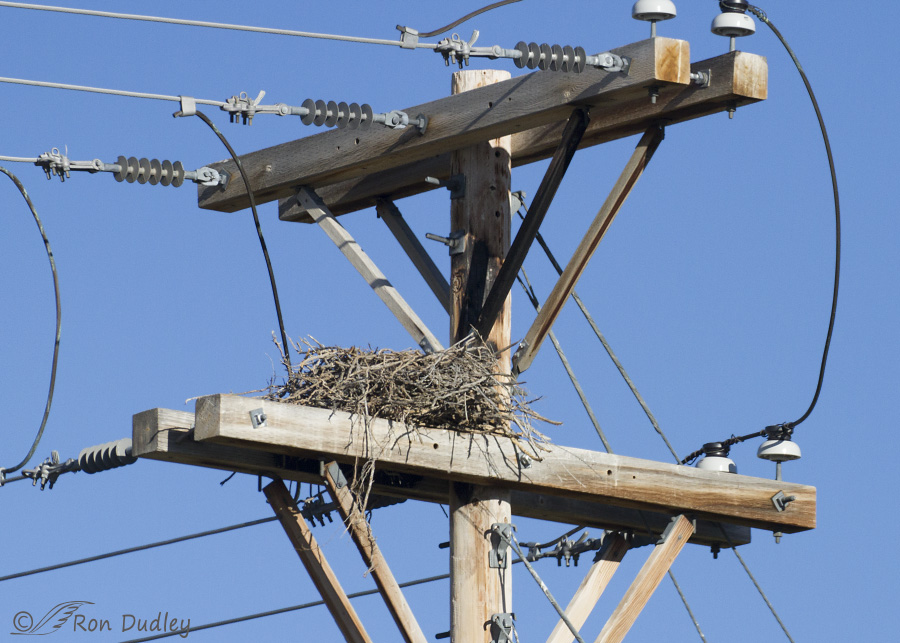
But yesterday, only four days later, another nest had been built by the ravens in the same spot on the pole. I’m amazed by the persistence and resilience of those ravens. I drove by this new nest several times yesterday and each time I inwardly applauded their pluckiness.
It’s very possible that the new nest was constructed in significantly less than four days. I wish I knew…
On this blog I’ve often mentioned the declining water levels of the Great Salt Lake and its negative effects on birds and wildlife. Yesterday morning I visited a remote area on the northeast end of the lake and the following photo may give readers some feel for what I’ve been talking about.
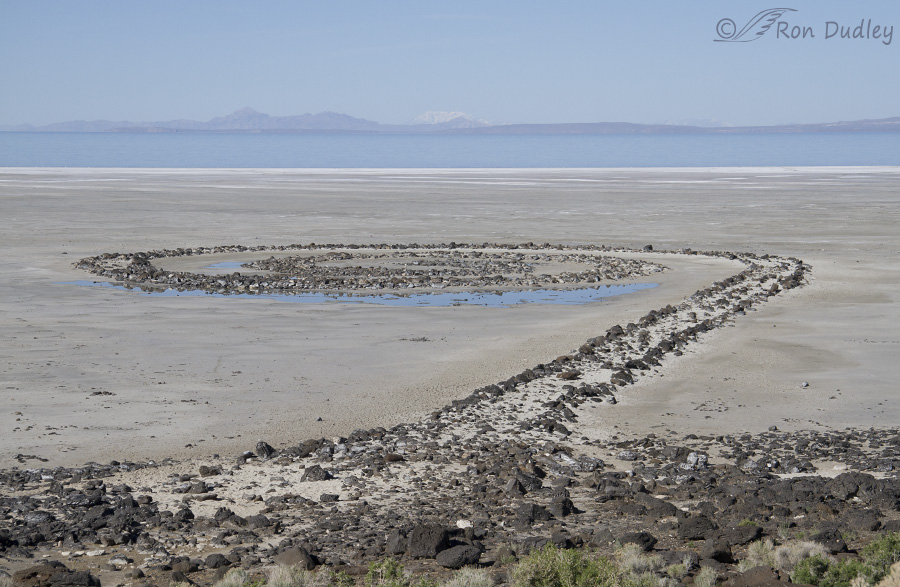
This is the Spiral Jetty – an earthwork sculpture constructed by American sculptor Robert Smithson in 1970. It’s made of basalt rocks and mud and the counterclockwise spiral is 15′ wide and 1500′ long as it juts into the lake from the shore. Depending on water level the jetty may be completely submerged in the lake or left high and dry on the beach.
This is what it looked like yesterday morning. The only water near the jetty is from recent rains and snow – the shore of the lake has receded to the far background. I can only guess how far it is to the lake but I’d estimate that it’s at least a mile. When you consider the size of this huge lake (only a small portion of it can be seen here) there’s a lot of water that isn’t there that should be.
And the main reason for the declining lake level isn’t drought – it’s overuse of the rivers feeding the lake by agriculture and industry. Recent plans have been made to take even more water from the Bear River before it enters the lake.
The continuing shortsightedness of humans simply astounds me.
Ron
Addendum: I believe I’ve now solved the mystery of why the meadowlark’s toe is bent upward in the first photo. If interested, see my response to Laura Culley’s comment below.


Like Laura yor pictures are ALWAYS “WOW” for me. Also I am currently reading ‘refuge ‘ by Terry Tempest Williams and the extremes from that to this is unbelievable. Also how wonderful for you to be so honoured to be a part of the effort to save these delightful sweet owls.
We have the same issue with water being diverted from rivers that feed the Sacramento River Delta (a key life-sustaining way point along the Pacific Flyway and delicate ecosystem that transitions fresh to brackish to sea water). The devious politicians attempting to divert billions of gallons of water to the south give their proposals names like “The Delta Restoration Project.”
I’m late getting to this today because I had to go to Bozeman. However, reading your blog is also a great way to END the day! Love the Meadowlark. This wind has been enough to ruffle lots of feathers in more ways than one!
WOW! The lake is really low! I’ve always been fascinated at the number and variety of birds the Great Lake attracts. Have the numbers diminished significantly recently?
Once again, your posts are interesting and educational, as well as inspiring.
Jane, yes, bird numbers have seemed to have diminished significantly as the lake recedes. However, that’s hard to assess accurately because the shoreline where the birds hang out is now so far away from reasonable access in most places.
Were the golden eagles still around?
No, they weren’t, April. We saw some in other areas though.
Lovely pictures Ron. My favorite is the Northern Harrier. I like the look in the bird’s eyes. The men that take care of the telephone lines in our area are always ripping apart Raven’s nest. It bothers me as well. I think they are to lame to think that “this is the bird’s home” We’re getting a bit of rain today in So. Calif. The birds are thrilled here!
Jean, I wondered if it could be the power company that did this…
Sigh on the human front. The sooner we learn that we need to look after our home (and her inhabitants) the better. Sadly I think greed and ignorance trump sense far too often. We play similar destructive and short-sighted games with water here too. I am frequently ashamed of our species.
Loved the birds though. And the resilience of those nest builders. I hope they survive and thrive.
“I am frequently ashamed of our species”
I often have the same thought, EC.
Is that “THE Ken”? The one that was so intrumental in getting you going…to the benefit of us all. I find the reason for the falling level of that great lake, that incredibly rich lake, very distressing….reminds me of Mono Lake and so many others….we just don’t learn!!! Greed, shortsightedness, waste and, above all, stupidity strike again!! A nice series is sadly offset by the receding shoreline…..makes me all the more in synch with Abbey than ever before…
Yup, it’s that Ken, Patty – he was like a brother to me and without him I probably wouldn’t be photographing birds (I’ve told that story before…).
Well HURRAY for Ken! 🙂
Many thanks for these shots, beautiful and very informative.
Shortsightedness is an understatement! Generally, as many humans continue to remove themselves from the natural system and think they are top dog, can do what we want with no ramifications the rest of us are in trouble. We need to share our Globe with wildlife and the natural system otherwise we will end up with the short straw! The more out of touch people become the more selfish and shortsighted industry and people become. Scary!
As a species we sure can be slow learners, can’t we, Dick? Scary indeed!
Very interesting
Charlotte
Thank you, Charlotte.
As usual, here’s the ridiculously redundant and repetitive OH WOW! I just love beginning my day with your blog.
Not that we’ll ever know for sure, but to me, the meadowlark’s foot looks like it might be a birth defect, that maybe its foot was twisted somehow in the egg or as a small nestling and never quite straightened? But obviously, this one is surviving quite well with it. I just love those floofy feathers blowing in the wind. I can’t wait to see and hear meadowlarks again.
With the juvie bald eagle, isn’t it interesting that even their beak shows their juvenile status? It doesn’t turn yellow until later, along with the white head and tail feathers that announce its adulthood. I’m GUESSING this is a two-year-old kiddo, still surviving and that’s good with all the dangers raptors face in their daily lives!
There’s so much magic in raptors, birds and critters overall. I have fond memories of watching a pair of Northern Harriers fly with fancy in the winds in north Texas, and they, like this one, didn’t seem to mind me watching them at all. Such beauty!
I hope that raven nest was toppled by winds, and it looks like that’s the case. I don’t want to think about the humans who can willfully decimate creatures in the wild. I will never understand how there’s a point in some humans’ minds that says it’s OK to kill, maim or otherwise injure other creatures. I just don’t get how that happens. I’m delighted that it’s early enough for those raven parents to rebuild and start their nest again. And they CAN rebuild rapidly. I’ve watched redtails rebuild an entire nest in three or four days, and since they continue nest building during incubation through to fledge, anything is possible with these guys.
The receding waters of the Great Salt Lake is beyond sad. I just don’t understand what we’re doing to this spinning rock. It used to be such an expansive and amazing paradise. Another thing I’ll never understand is how we (collectively) don’t get how this Earth sustains us and allows for our survival. Maybe we’ll get it when we’re teetering on the brink of our extinction?
Do you ever wish you could have gone along with the Lewis & Clark expedition (ignoring that their expedition marked the beginning of How the West was Won with genocide and overall decimation through those Manifest Destiny and American Exceptionalism ideas? I would just love to have seen North America through their eyes and experiences, back before all that happened.
Thank you so much for this meander through your world!
“the meadowlark’s foot looks like it might be a birth defect”
Laura, I believe I’ve solved the mystery. I took 86 photos of this bird and in most of them the toe is in a normal position. But in a dozen of them, all in a series, the toenail seems to be caught between two feathers coming down from its flank. I cropped in tightly on several of them and I’m confident that’s why the toe is bent upwards.
I’ve often wished I could have been along on the Lewis and Clark expedition because I’ve studied them for years and been fascinated by their accomplishments. I just finished reading (for the second time) “Undaunted Courage” by Stephen Ambrose – an incredible book about their amazing adventure. Camp Disappointment was just outside of the Montana town (Cut Bank) where I grew up. The only violent encounter between the expedition and Indians occurred nearby (2 members of the Blackfeet tribe were killed) at what today is called the Two Medicine Fight Site. When my cousin Ken Dudley was a boy scout it was his scout troop that discovered and proved where the fight site actually was. Ken was always very proud of that.
That’s good to hear about the meadowlark’s foot. I’ve seen birth defects like that, but the birds involved don’t seem to bother with it much and just get on with life, like they do.
How cool about your cousin verifying the sight. I BET he’s proud and he should be!
OK, so another book to add to the collection (I love books). I’ve done a bunch of research about their journey, too and it’s just fascinating. Oh how I’d loved to have taken that journey. And yes, not surprising about the lack of violence (other than the two who were killed). If I could stop time, I think I’d stop it right then and there. No, maybe before Plymouth. That would be better. Sigh, alas, that’s not available. I know there are all sorts of conflicts there. Life is just full of conflicts along with little disappointments!
On the “short sightedness of humans” Years ago they planted Sarcoptic Mange in Yellowstone to help get rid of Wolves and Coyotes – it’s still around affecting the wolves and they have to hunt/eat more, particularly in winter, to survive with it. Some “studies” are now being conducted on the situation 🙁
That’s something I’d never heard about, Judy. I’ll be doing some research on it.
Good photo’s Ron! 🙂 Eagle sure has a LOT of white on it – I’ve never seen one with that much. The Meadowlark’s leg looks like it’s really turned in – may be what’s causing the toe to stick up like that – bracing itself in the wind perhaps? The Raven nest is interesting – a quick glance and I’d think it was an Osprey nest! 🙂 They plant poles/platforms for them in places around Townsend to keep them off the power poles. The lake sure is low! Does that make it more salty than usual?
“Does that make it more salty than usual?”
Yes, it does, Judy – though that equation is complicated by causeways bisecting the lake that make parts of the lake more saline than others.